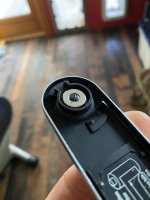Andrea Taurisano
il cimento
Hello knowledgeable folks!
One of my Barnack cameras, a 1932 Leica II, does this funky thing on the negatives. The exposed area isn't centered on the neg but partly ends up on the sprocket holes (bottom side of the image). But what puzzles me is that all frames are also slightly tilted towards the right hand side. Almost as if the metal frame that you see around the shutter curtain was tilted, but I don't see how that can be the case. Anything that can be adjusted to realign film? Do share a thought if you like. Thanks.

One of my Barnack cameras, a 1932 Leica II, does this funky thing on the negatives. The exposed area isn't centered on the neg but partly ends up on the sprocket holes (bottom side of the image). But what puzzles me is that all frames are also slightly tilted towards the right hand side. Almost as if the metal frame that you see around the shutter curtain was tilted, but I don't see how that can be the case. Anything that can be adjusted to realign film? Do share a thought if you like. Thanks.




